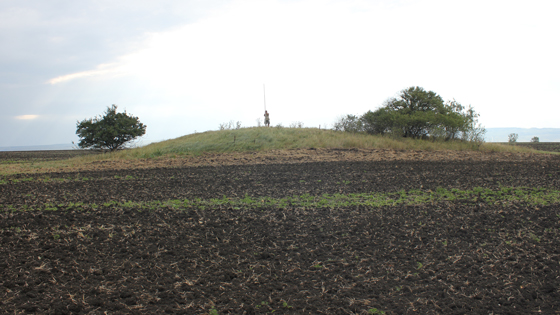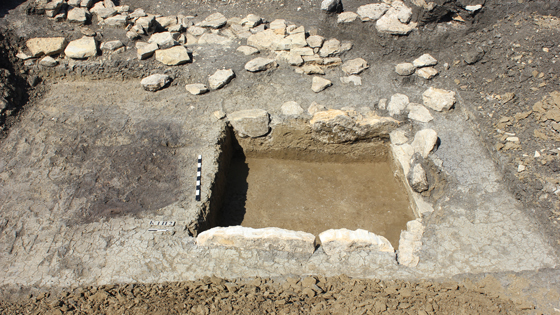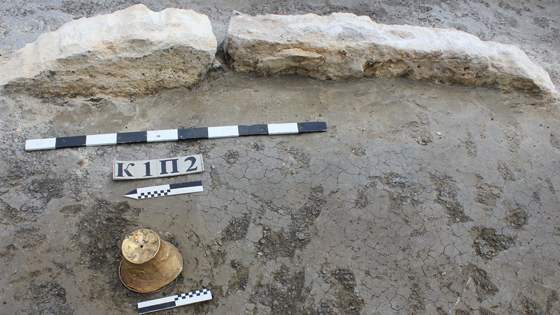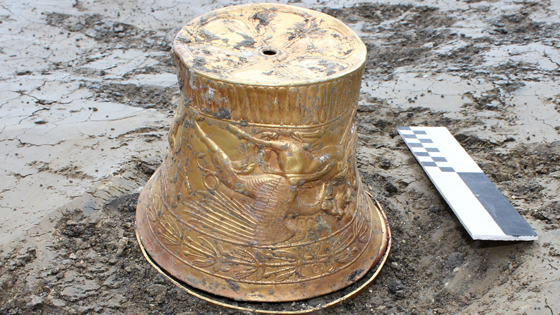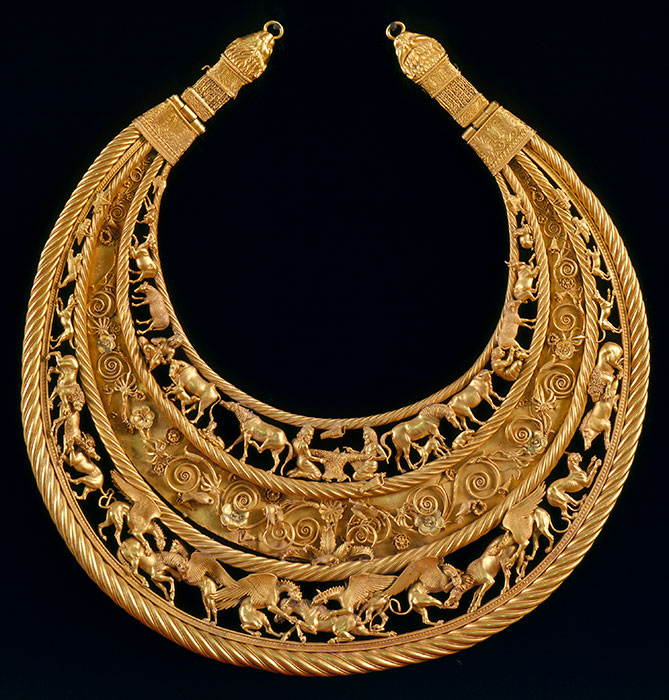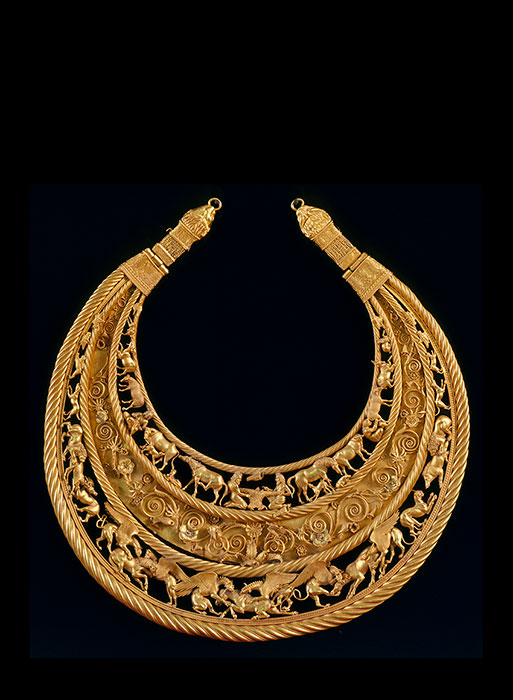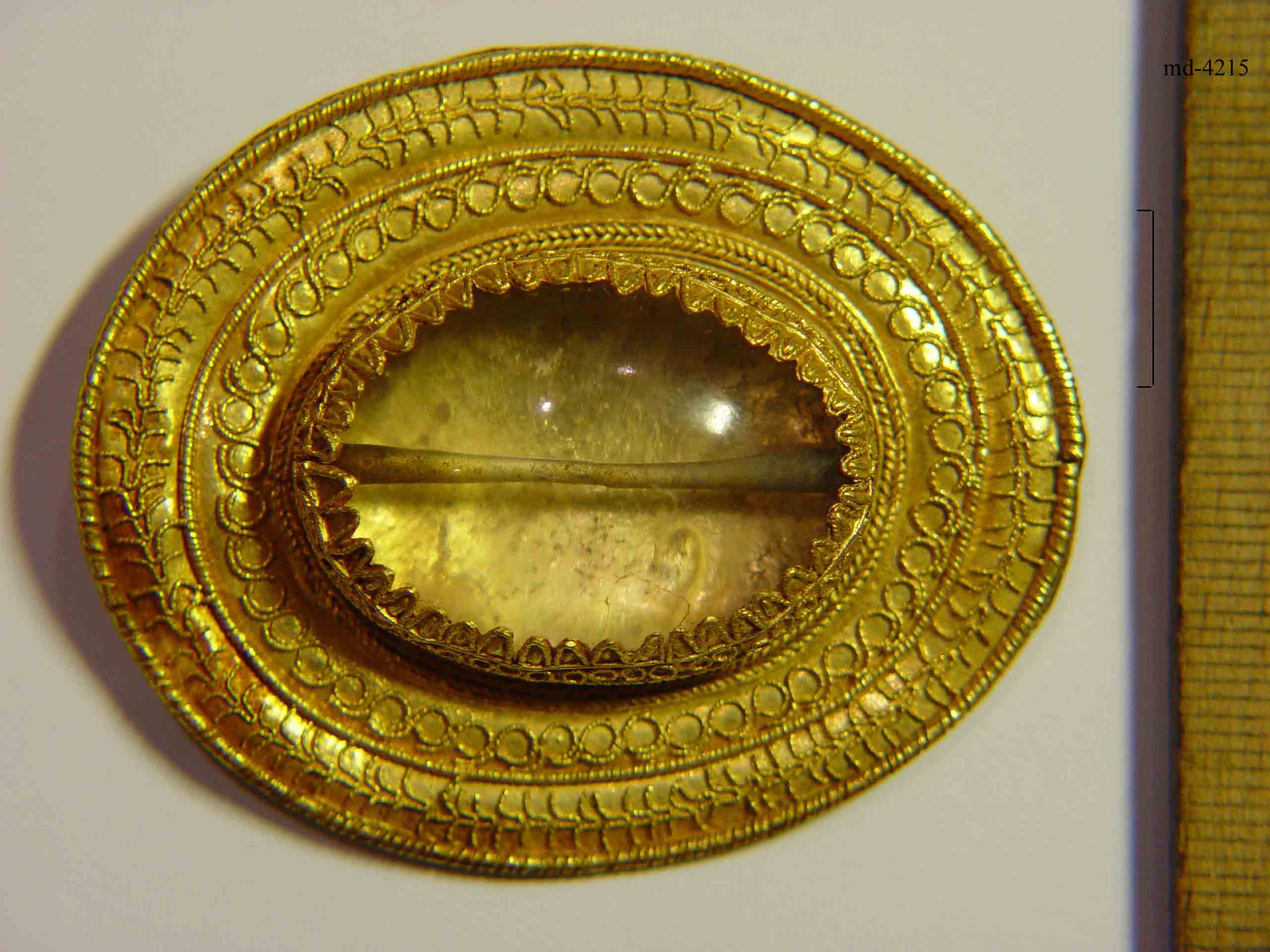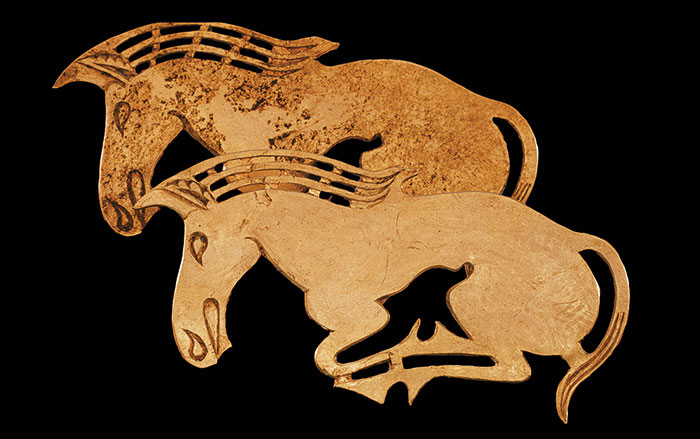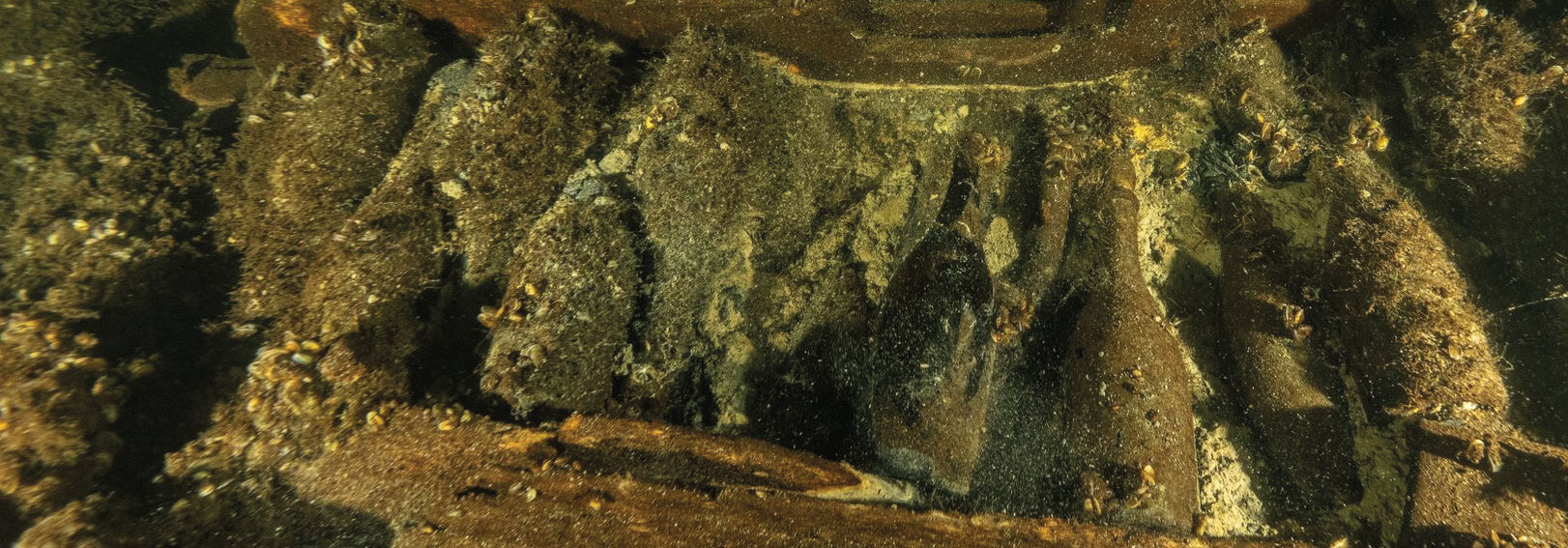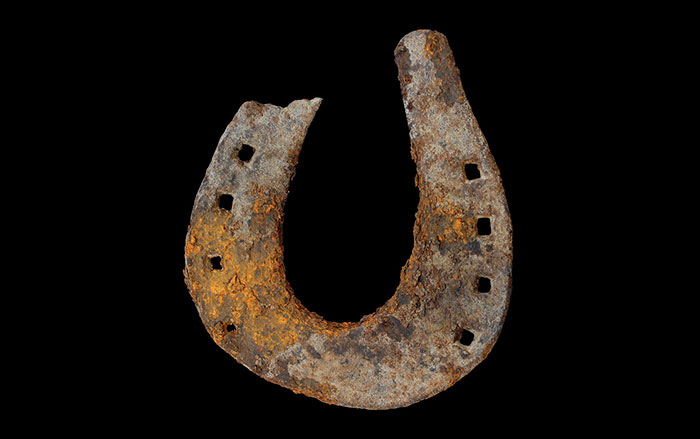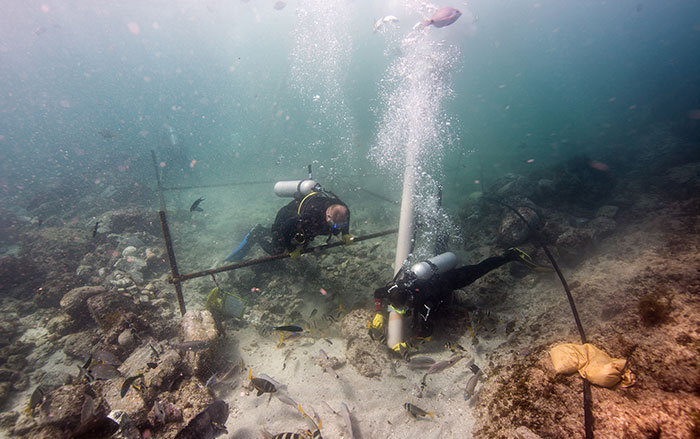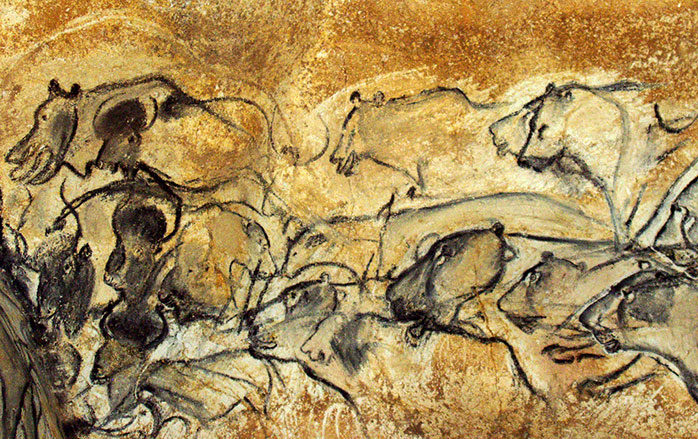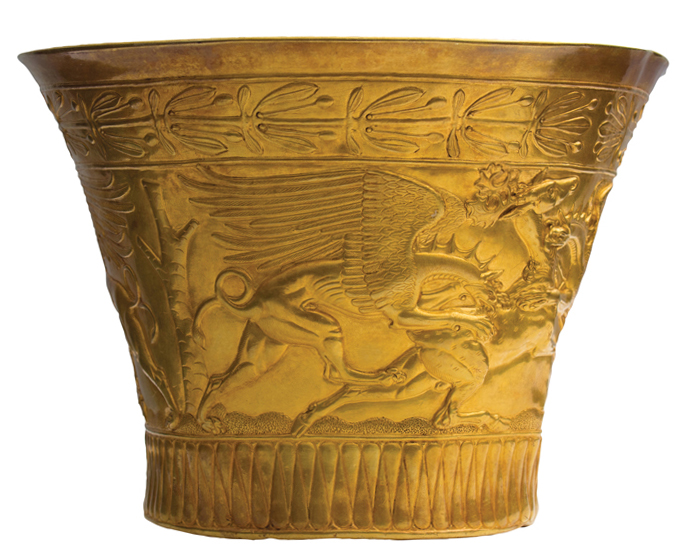
Russian archaeologist Andrey Belinski wasn’t sure what to expect when he found himself facing a small mound in a farmer’s field at the foot of the Caucasus Mountains. To the untrained eye, the 12-foot feature looked like little more than a hillock. To Belinski, who was charged with excavating the area to make way for new power lines, it looked like a type of ancient burial mound called a kurgan. He considered the job of excavating and analyzing the kurgan, which might be damaged by the construction work, fairly routine. “Basically, we planned to dig so we could understand how it was built,” Belinski says. As he and his team began to slice into the mound, located 30 miles east of Stavropol, it became apparent that they weren’t the first people to take an interest. In fact, looters had long ago ravaged some sections. “The central part was destroyed, probably in the nineteenth century,” Belinski says. Hopes of finding a burial chamber or artifacts inside began to fade.
It took nearly a month of digging to reach the bottom. There, Belinski ran into a layer of thick clay that, at first glance, looked like a natural feature of the landscape, not the result of human activity. He uncovered a stone box, a foot or so deep, containing a few finger and rib bones from a teenager. But that wasn’t all. Nested one inside the other in the box were two gold vessels of unsurpassed workmanship. Beneath these lay three gold armbands, a heavy ring, and three smaller bell-shaped gold cups. “It was a huge surprise for us,” Belinski says. “Somehow, the people who plundered the rest didn’t locate these artifacts.”
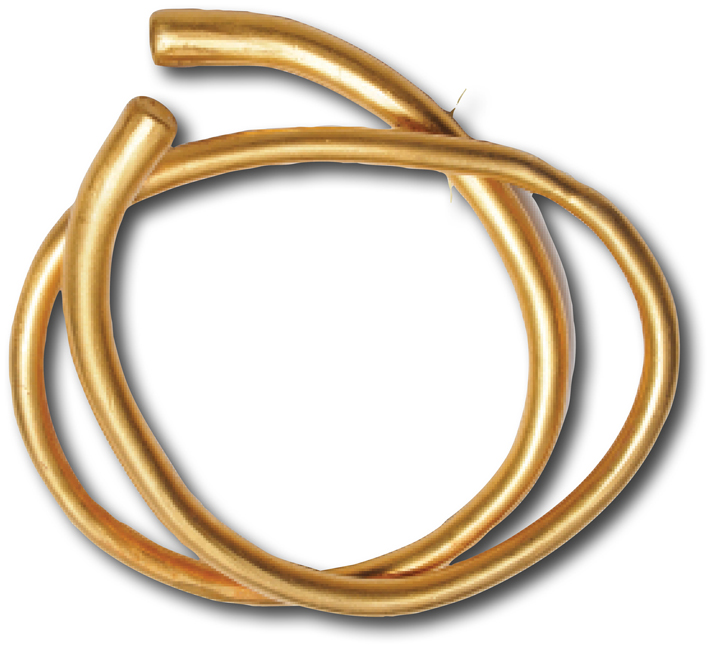
As he continued to excavate the area surrounding the kurgan, he spotted postholes near the stone box, as though tree trunks had once been sunk in the earth to support a pavilion or roof. Belinski and Anton Gass of the Prussian Cultural Heritage Foundation in Berlin, whom Belinski had invited to participate in the excavation, realized that they had found something far beyond a simple burial mound. In fact, some scholars think the site may have been the location of an intense ritual and subsequent burial rite performed by some of the ancient world’s most fearsome warriors.
From about 900 to 100 B.C., nomadic tribes dominated the steppes and grasslands of Eurasia, from what is today western China all the way east to the Danube. All across this vast expanse, archaeological evidence shows that people shared core cultural practices. “They were all nomads, they were heavily socially stratified, they had monumental burial structures and rich grave goods,” says Hermann Parzinger, head of Berlin’s Prussian Cultural Heritage Foundation and former head of the German Archaeological Institute. Today, archaeologists refer to the members of this interconnected world as Scythians, a name used by the Greek historian Herodotus.
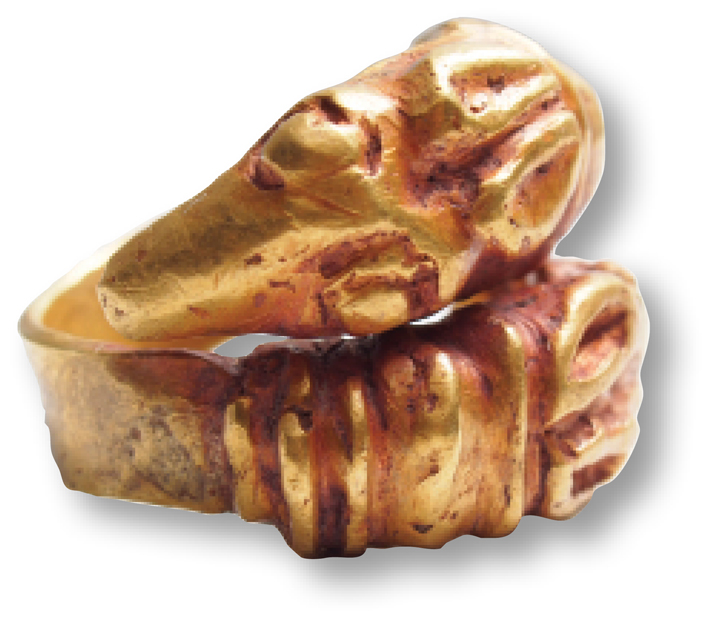
Although the Scythians were united by their nomadic, horse-centered lifestyle, historians and archaeologists do not think they were ever a single political entity. Based on regional differences in their art, artifacts, and burial practices, scholars posit that they were, rather, a collection of tribes who spoke related languages and had a broadly shared artistic and material culture. They had no written language and their nomadic lifestyle has left relatively little in terms of settlements for archaeologists to uncover. Thus, modern scholars have had to rely heavily on the accounts of ancient historians to interpret the archaeological evidence. “Archaeological finds are, by their nature, mute,” says Askold Ivantchik, director of the Centre for Comparative Studies of Ancient Civilizations at the Russian Academy of Sciences in Moscow. “The main source we have is texts from other cultures, primarily the Greeks and Romans.”
The historians’ accounts are rarely complimentary. The ancient Greeks dismissed their neighbors to the west as “mare milkers” and drunks, and the Scythians’ nomadic lifestyle must have seemed strange and threatening in contrast to their own settled urban one. And the Greeks weren’t the only ancient power the steppe nomads encountered—and sometimes clashed with. The Scythians periodically crossed the Caucasus Mountains to terrorize the mighty Assyrians and Medes to the south. There is even textual evidence from Persian and Egyptian sources that they vanquished Assyria, pushed west into modern-day Syria, plundered Palestine, and made it as far south as Egypt’s borders, where a cowed pharaoh paid them to back off in the sixth century B.C.

Though the Caucasus is dotted with Scythian burial mounds, the region has long been ignored in favor of more monumental kurgans farther west, or better-preserved tombs many hundreds of miles to the east. In fact, over the last few decades, Parzinger and others have uncovered Scythian tombs in the Altai Mountains, where Russia, China, Mongolia, and Kazakhstan meet today, preserved by permafrost and ice. The bodies and grave goods in these burials have added to what was already known about Scythian culture from earlier excavations in western Russia and Ukraine, some of which yielded fantastic gold artifacts. But the site excavated by Belinski, dubbed Sengileevskoe-2, is the first such golden treasure to be uncovered in the Caucasus. “This is one of the most outstanding archaeological discoveries of Scythian artifacts in recent years,” says Parzinger. “They are sensational.”
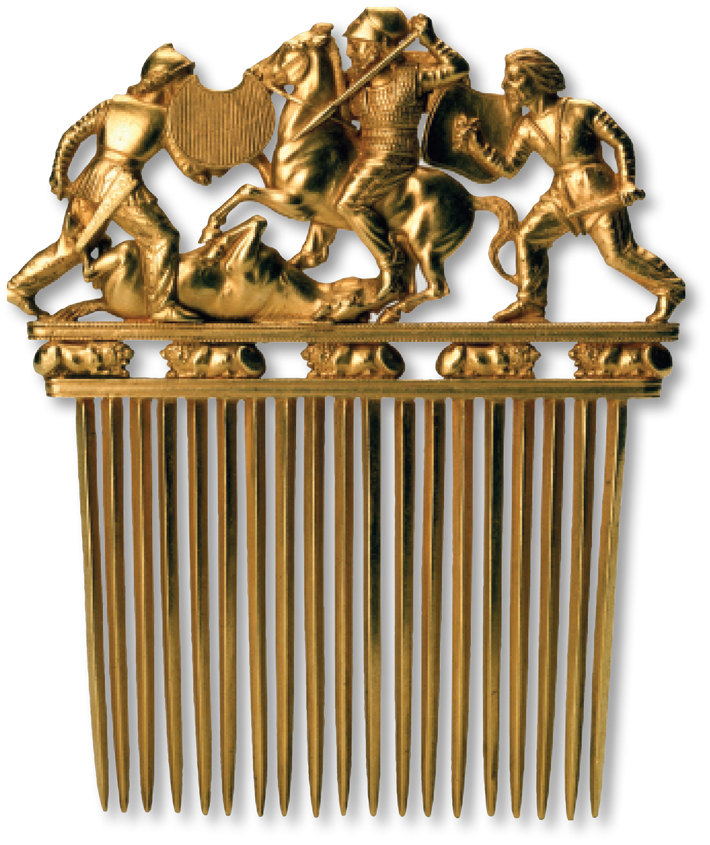
The find was so remarkable, Belinski says, that when he showed the objects to Scythian experts in St. Petersburg, they initially suspected foul play. “Some scientists from the Hermitage said that it was unbelievable,” he says. “At first, they claimed it was fake, until they heard that everything was found in situ, at an excavation. If the artifacts had emerged from the black market, they would certainly have been dismissed as modern forgeries.” Adds Gass, “This sort of thing comes along once every 50 years. The quality of these objects, their craftsmanship, is nearly unique.”
Though undeniably authentic, the discovery still raises other questions about the objects and what they can tell archaeologists about the warrior-nomads who left them behind. The vessels are likely not the product of the Scythians themselves, but of ancient Greek craftsmen working on commission somewhere close, such as on the northern Black Sea coast. “It’s not only solid gold,” says Gass. “It took the highest art of the Greek world to produce work like this.”
The first mystery is what the artifacts might have been used for. Small cup- or bell-shaped vessels with holes in the bottom (or top) are common in Scythian graves. They are often made of bronze and, rarely, of gold or silver. Archaeologists have suggested they functioned as decorative ornaments, originally hung from horses’ bridles. At first, Belinski thought the two large, elaborately decorated artifacts from Sengileevskoe-2, each of which also has a hole, were simply oversized examples of these common horse trappings. But there was something odd about the vessels. When he pulled them out of the ground 2,400 years after they had been buried, he noticed crusty patches of sticky black residue on both. Before cleaning the gold, Belinski asked the crime lab in Stavropol to take samples for analysis. The results came back positive for opium. Looking at the residue under a microscope, experts identified cannabis particles as well. The residue seems to confirm stories told by ancient authors, Herodotus among them, that the Scythians marked important occasions with drug-fueled rituals. “A dish is placed upon the ground, into which they put a number of red-hot stones, and then add some hemp-seed,” the Greek historian writes. “Immediately it smokes, and gives out such a vapor as no Grecian vapor-bath can exceed; the Scyths, delighted, shout for joy.” Hemp seeds and small metal pipes have been found in frozen tombs far to the east, but it was never clear how they were used, and some archaeologists have argued the plants were medicinal. The residue on these gold vessels appears to be evidence of a more meaningful ritual. There’s no sign of charring or burning, so Belinski thinks the opium was consumed as a concentrated drink, perhaps while cannabis was burning nearby. “That both drugs were being used simultaneously is beyond doubt,” he says.
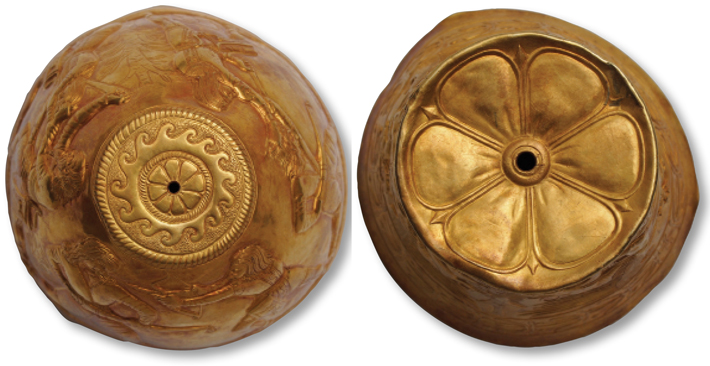
The results of the residue analysis provide more than just titillating evidence that the ancient Scyths were enthusiastic about the mind-bending power of certain plants. It has long been known that in cultures around the world, drugs were—and often still are—at the center of religious rituals. The drink itself may have had a holy aspect, like an embodiment of the divine.
Both Gass and Belinski suggest that the small cups, which are not much bigger than a thimble, were worn or carried the way Christians wear crosses today. If they’re correct, it could help explain ritual practices all across the Scythian world. “These conical objects with holes are known from other assemblages, but interpretation has always been a problem,” says Ivantchik. “We now know the purpose was preparation of opium or a narcotic substance for sacred rites. Cultic connections with such rare substances are very important. That Belinski detected the use of these substances is another proof the objects have cultic character.”
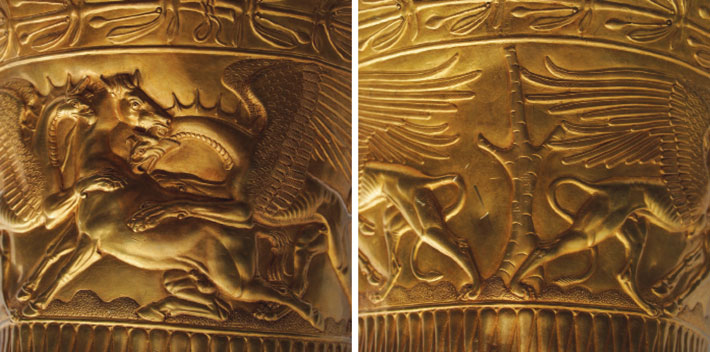
The collection of this very particular type of artifact in this location may also provide a strong clue as to what may have been happening on that hilltop with its majestic view of the valley below in 400 B.C. If the vessels were holy chalices for a powerful narcotic, were the stunning decorations on their outsides packed with meaning as well? Do their motifs, as Belinski and Gass wonder, reveal insights into the Scythian worldview—and perhaps provide even more confirmation of Herodotus’ histories?
The two vessels were nested together, and it seems clear that they were intended as a matched set: One has a flat bottom, as would a bucket; the other is more rounded, like a bowl, with a smaller flat surface on the bottom. Overturned, the bowl covers the bucket like a lid. The decorations also give clues as to their orientation: The lower vessel’s figures are upright when the vessel is sitting on its base, while the upper one is intended to be displayed with the opening facing down.
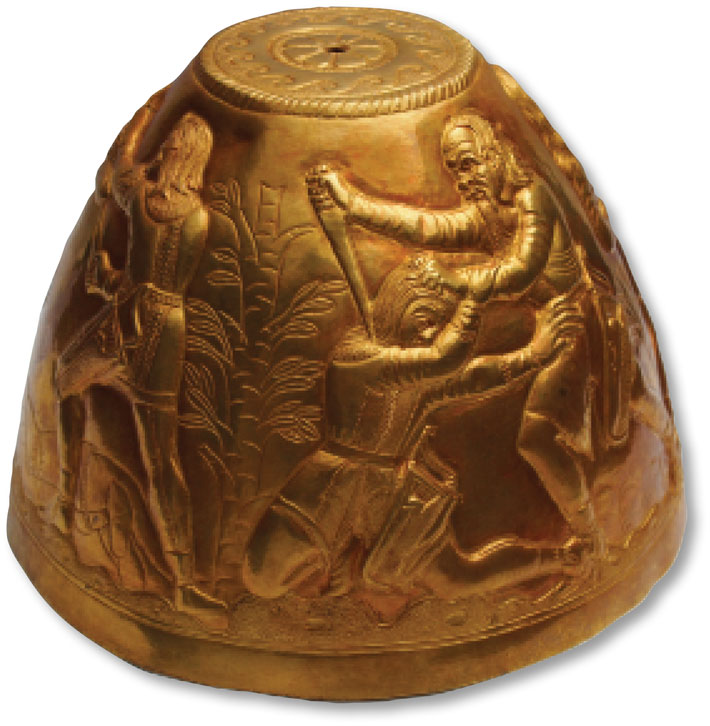
On one side, the flat-bottomed vessel displays two griffins ripping the flesh from a rearing stag; on the other, a pair of griffins savages a struggling horse. The ground beneath their hooves and claws is bare, the trees in the background, dead. The bowl-shaped upper vessel is decorated with detailed images of six men engaged in combat and two men—one beheaded and scalped—dead on the ground. There is grass beneath the warriors’ feet, and trees bearing leaves separate the scenes. The vessels’ fantastical animals echo images of real-world creatures tattooed on well-preserved Scythian bodies found thousands of miles away, in the highlands of Russia and Mongolia. More strikingly, they are nearly identical versions of mythological creatures depicted on gold objects from tombs near the Black Sea, a few hundred miles to the west. The warriors, too, resonate in other finds, although Gass and Belinski emphasize that the fine detail on the Sengileevskoe-2 vessels is unparalleled.
Though the fearsome griffins on the lower vessel are spectacular, it is the fighters on the upper bowl that intrigue the archaeologists the most, for they recall Herodotus’ claims of having firsthand experience visiting the nomads. The historian’s lengthy discussion of Scythian history, rituals, and burial practices begins with an odd story: The Scythians spent decades waging war and invading their settled neighbors to the south. They left their lonely wives behind, and...events transpired. “The Scythian women, when they saw that time went on, and their husbands did not come back, had intermarried with their slaves,” Herodotus reports. Returning home after a 28-year absence, the warriors found that their wives had done more than marry the slaves they left behind—they had had children, who were now young men. In what Gass calls the “Bastard Wars,” the returning Scythians supposedly battled their illegitimate rivals. He is intrigued by the possibility that the upper vessel’s victorious warrior, old, bearded, and wrinkled, and the younger man he is slaying are a reference to the wars Herodotus chronicles. Perhaps, he suggests, the scene on the upper bowl commemorates this victory of age over youth.
Appealing as the literary and historical parallels might be, according to Ivantchik, the Greek artisans who likely made the vessels were probably thinking in more symbolic terms. “It’s very rare to see representations of historical events in Greek art,” he says. “The imagery on the vessels is very interesting and important, but interpretation is a delicate problem.” Belinski agrees, and considers Gass’ theory a stretch. “Why would this not particularly sacred saga be on sacred vessels?” he asks. Instead, he posits that the old man slaying a younger warrior is more likely a metaphor, or a depiction of an unknown ritual. “Until we find written sources, we can’t say for sure,” he adds.
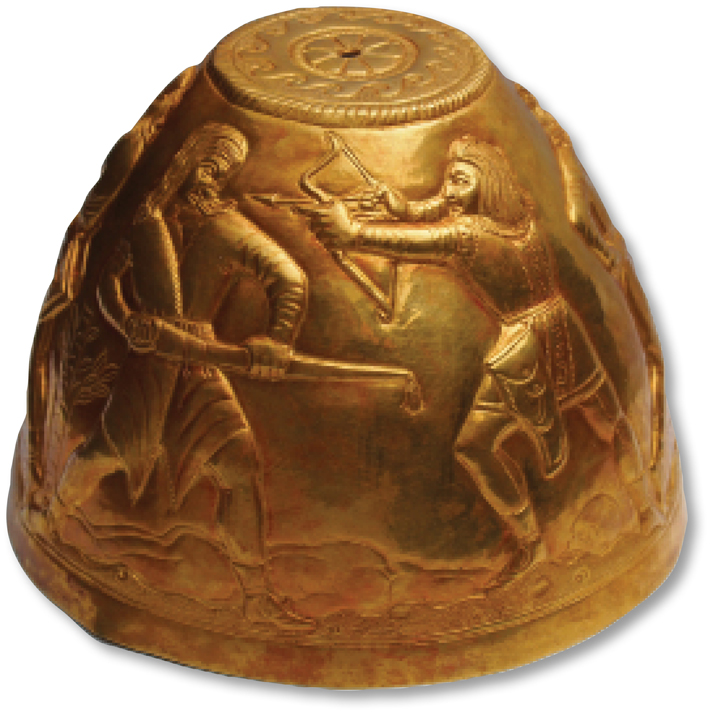
While they disagree on the specifics, both Belinski and Gass agree that the vessels were intended to fit together, with the flat-bottomed one on the bottom and the curved one on top. Seen that way, Belinski thinks the gold vessels could be a representation of how the Scythians saw the universe. “There’s an underworld of fantastical creatures and death, and an upper world of the living and of heroes, where we are,” he says. However, when they were buried under the kurgan, the bowl-shaped vessel was nested inside the pail-shaped one and both were placed with their openings down. That’s unlikely to be accidental, says Gass. “The original order was upended, probably intentionally. That the vessels were overturned shows the world sinking into chaos.”
Herodotus’ lengthy descriptions of the Scythians’ lifestyle and rituals may come from personal experience. The early historian probably traveled to Greek colonies on the Black Sea coast, outposts near the mouth of the Dnieper River where Greek traders would have come into contact with the farthest-flung outskirts of Scythian culture. Scholars say the Sengileevskoe-2 gold ties the Scythians of the Caucasus to these Greek colonies in a way previous finds haven’t.
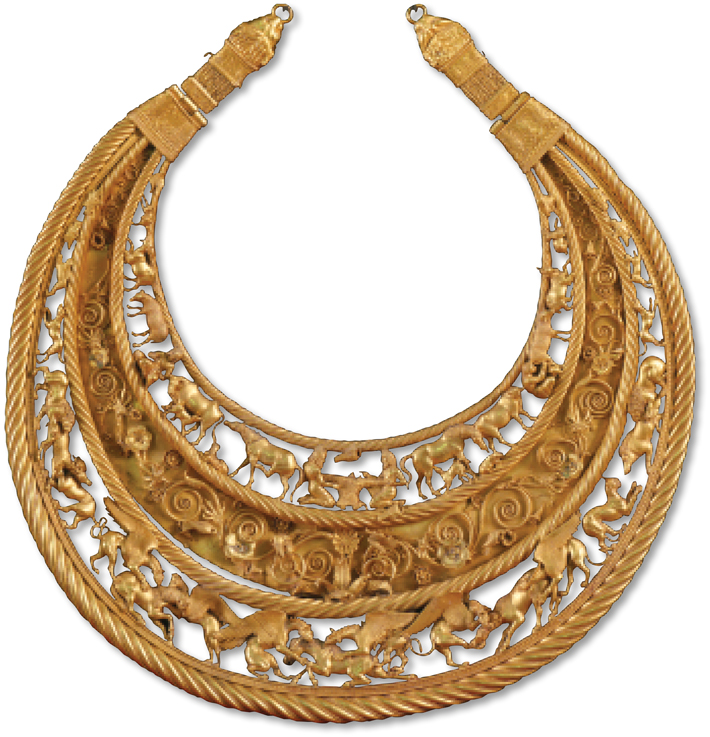
That connection is significant because some of the most sensational Scythian gold artifacts, such as the Tolstaya Mogila pectoral uncovered in 1971, have emerged from kurgans in the plains north of the Black Sea. Made of 24-karat gold, the pectoral is a foot across and weighs 2.5 pounds. Although the artifacts were discovered nearly 300 miles apart, the pectoral’s intricate gold figures—including griffins, horses, and kneeling warriors—so closely resemble the decorations on the Sengileevskoe-2 vessels that they might be from the same goldsmith’s hand. These similarities are helping archaeologists demonstrate that the Scythian world was deeply interconnected, even over vast distances.
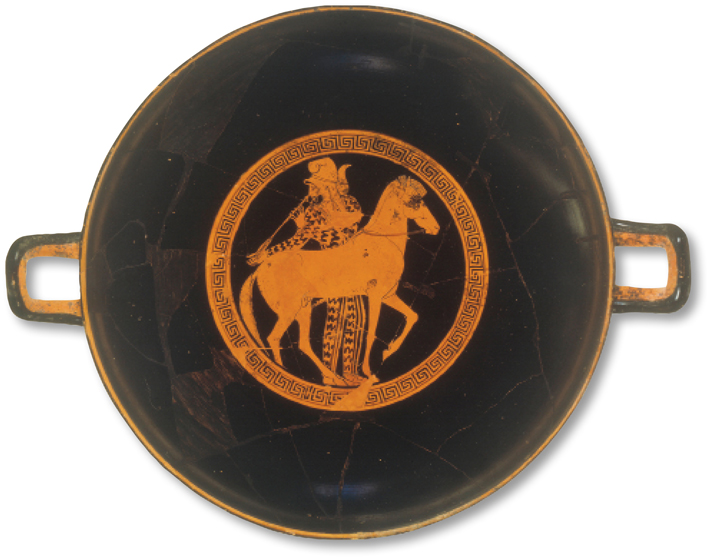
The golden vessels, the human remains—which, for now at least, archaeologists are interpreting as a human sacrifice rather than a full burial—and the remains of a substantial construction perched on top of the mound are likely indications that this was some sort of altar or ritual spot, and had once probably been used for an important ceremony, perhaps of the kind Herodotus describes. “There could have been some type of a roof construction, and there may have been hanging banners or standards with flags as well,” says Gass. “We’re not sure, but there was something major there.” After the ritual, the kurgan was built on top. Since most kurgans are clearly tombs, archaeologists say there are few parallels for a construction like this. Parzinger suggests that empty kurgans were rarely reported or written about in the past, and might be more common than once thought. Gass and Belinski think the Sengileevskoe-2 kurgan was a cenotaph, a symbolic burial built to mark some tremendous upheaval in the Scythian world, perhaps the death of a king who was buried elsewhere. “Something important happened,” Gass says. “But what?”
Today the gold from the Sengileevskoe-2 kurgan sits in a museum safe in Pyatigorsk. The next phase of research involves continuing to analyze and understand the landscape around the kurgan, which is a complex network of ditches, rings, and other earthworks Belinski and Gass located during geophysical surveys. Their colleagues are eagerly awaiting their results. “This new work could potentially tell us even more about the rituals and performance involved in erecting these huge kurgans than this hoard alone can,” says Sören Stark, an archaeologist at the Institute for the Study of the Ancient World at New York University. “We thought the kurgan was it, but it’s becoming clear that there’s much more.”
Slideshow: Inside a Scythian Burial Mound
When archaeologists recently began excavating a small burial mound in southern Russia they had low expectations. But to their surprise, they found two gold vessels, as well as an array of other gold objects, that made up one of the most elaborate Scythian hoards ever discovered. Below are images from the excavation showing the context of these spectacular finds.
